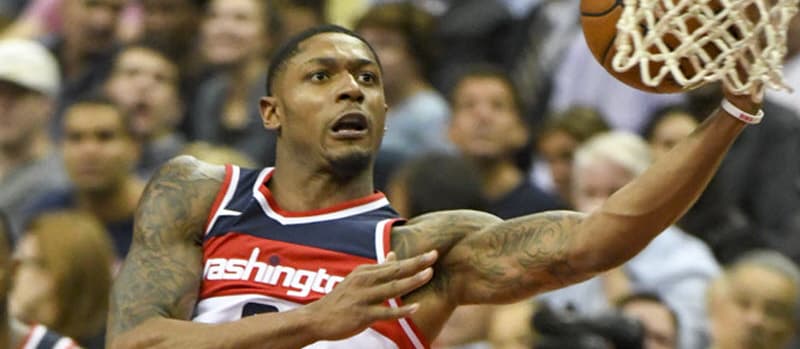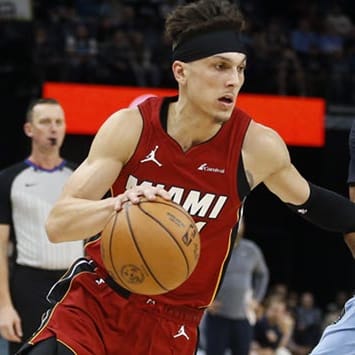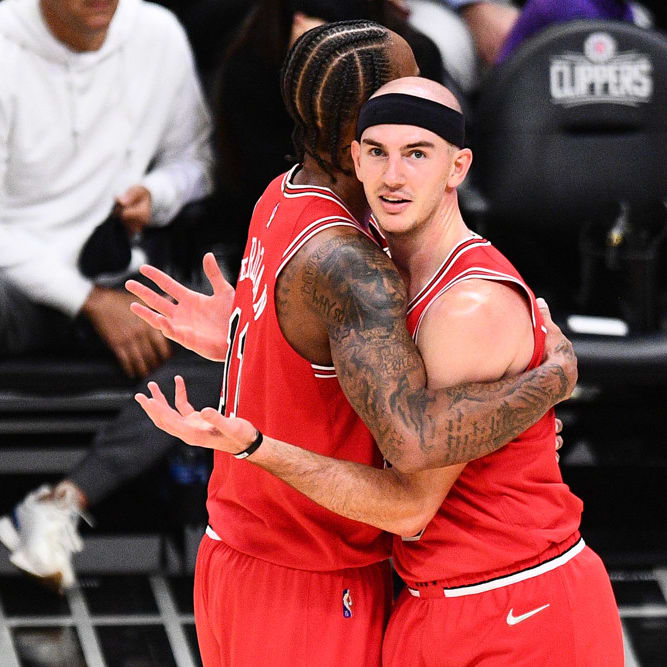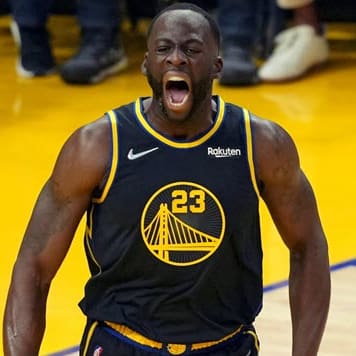This article is part of our Season Review series.
It's never too early to start preparing for next year's fantasy basketball season.
One way we'll help you do that is by reviewing each team, highlighting what went right and what went wrong in 2017-18. We'll also take a look at the current state of the roster to see what moves they could potentially make over the summer, and what impact those could have, from a fantasy perspective.
As we continue to work our way through the reverse order of the regular season standings, it's time to examine the Clippers, Wizards, and Bucks.
 LOS ANGELES CLIPPERS
LOS ANGELES CLIPPERS
The Good
For a team that traded its best player in Chris Paul before the season began, its second-best player in Blake Griffin before the trade deadline, and had Danilo Gallinari play just 21 games, the Clippers did exceptionally well to finish 42-40. The Clips played at the seventh-fastest pace (98.7), scored the eighth-most points per 100 possessions (110.3), had the 10th best true-shooting percentage (56.4) and allowed the ninth-lowest opponent three-point percentage (35.6%), despite only six players on the roster appearing in more than 61 games. A team shouldn't be fighting for a postseason berth when Austin Rivers and Wesley Johnson are third and fourth in total minutes. Doc Rivers deserves more recognition than he received.
Aside from coach Rivers, much of the credit has to go to Lou Williams, who had arguably the best season of his career at 31 years old, averaging 22.6 points and 5.3 assists with 57.4% true shooting. In Yahoo! leagues, he held a preseason rank of 60, but ended up finishing 20th in total fantasy production. The Clippers also managed to sign him to a three-year, $24 million extension, one of the more team-friendly deals in the league.
The Clippers' younger players stepped up, as well. Tobias Harris fit right in after coming over from Detroit (19.3 points per game, 41.4% from three), Austin Rivers (15.1 points, 4.0 assists,) has developed into a solid combo-guard, and Montrezl Harrell (11.0 points on 63.5% shooting in 17.0 minutes) projects to be a great option off the bench. All three players out-performed their preseason fantasy projections. Harris was barely projected as a top-100 player but ended up finishing 54th. Rivers was projected 137th and ended up 112th, while Harrell was projected 264th and finished the year as a top-200 player.
Finally, as much as I'm a fan of Blake Griffin, finding a way to move his potentially crippling five-year, $173 million deal and get a consistently improving young player in Harris in return may turn out to be one of the better trades in franchise history.
The Bad
Mostly injuries, but also rebounding. Despite having one of the better rebounding big men in the league, LA gave up the third-most offensive rebounds per 100 possessions (10.7).
On the injury front, Milos Teodosic played 45 games, Gallinari played 21, Patrick Beverley played 11 and Avery Bradley appeared in just six games after coming over as part of the Griffin deal. With even a relatively healthy roster, the Clippers likely would have been a playoff team.
Aside from that, it's probably fair to bring up DeAndre Jordan. Suggesting that things went wrong for Jordan is certainly an overstatement, but he showed concerning regression as a shot-blocker. From 2010-11 to last season, Jordan averaged 2.0 blocks per game. That number dropped to a disappointing 0.9 per game in 2017-18, while Jordan's block rate fell to just 2.4%, more than two percentage points lower than his previous career-low. His field goal percentage also dropped from 71.4% to 64.5%, but some regression was expected with the departure of Chris Paul. However, Jordan did raise his free-throw percentage from 48.2% to 58.0%, helping to keep his scoring average in the double-digits. All things considered, he was projected to be the 44th best fantasy player, but ended up 69th.
The State of the Franchise
While it seems safe to assume Rivers and Teodosic pick up their player options for next season, that same can't be said for Jordan. The big man's $24.1 million option is probably more than he could garner for next year on the open market. However, declining the option in favor of a longer-term deal for more guaranteed money is a very realistic possibility. If he declines and LA opts to let Bradley and Harrell walk, the Clippers would have about $88 million on the books, giving them room to make some noise in free agency with the cap projected at $101 million.
On the other hand, if Jordan accepts his player option, the Clips will have less free-agent flexibility this summer, but could potentially move him in a trade. Putting Jordan (and, more importantly, his salary figure) on the block with two first-round picks and possibly other assets, LA could could to make waves during the draft trying to trade for someone like Kawhi Leonard.
Either way, the Clippers have maneuvered themselves into being one of the most flexible teams in the league, immediately capable of beginning a traditional rebuild by trading expiring contracts for more picks or attempting to get a star player to improve and make the playoffs next season.
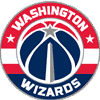 WASHINGTON WIZARDS
WASHINGTON WIZARDS
The Good
The Wizards made the postseason despite John Wall appearing in just 41 games and having an overall down year when healthy. Washington was relatively middle-of-the-road in pace (18th, 96.6), points per 100 possessions (14th, 109.3), opponent points per 100 possessions (16th, 108.7) and true shooting percentage (12th, 56.0%). What helped the Wizards remain afloat was keeping turnovers relatively even with Wall often out of the rotation (0.3 fewer turnovers per 100 possessions than their opponents), offensive rebounding rate (9th, 23.5%) and allowing the fifth-lowest three-point percentage (34.9).
Washington also got unexpected contributions from Tomas Satoransky, who started at point guard while Wall was on the shelf. Drafted 32nd overall in 2012, Satoransky was projected as a three-position player given his all-around skillset and high basketball IQ. That all came together when Wall missed 27 games from Jan. 27 to March 29, with Satoransky averaging 10.4 points, 6.0 assists, 4.1 rebounds and 1.1 steals and 1.0 threes while shooting 53.6% from the field and 52.8% from deep. As a result, he significantly outpaced his preseason fantasy projection (269th), instead ending up as the 159th-ranked player by total production.
Bradley Beal and Otto Porter once again turned in quality seasons. Beal averaged a career-high 4.5 assists to go along with 22.6 points while appearing in all 82 games, ranking as the 17th-best fantasy player. Porter continued his remarkably efficient three-point shooting -- 1.8 makes per game at 44.1% -- and coupled it with 6.4 rebounds and 1.5 steals per contest. He also stayed relatively healthy, playing in 77 games and ranking 25th in total fantasy production, which outpaced his preseason rank of 41.
The Bad
Most of Washington's issues centered around the basket. The Wizards were subpar on the defensive boards, ranking 18th in defensive rebound percentage (77.1). They also fouled too much, allowing the sixth-highest free-throw rate (.212). The Wizards also allowed the third-highest opponent field-goal percentage at the rim (69.5%), including the eighth-most dunks (355).
Much of that starts with Marcin Gortat, who had by far his least productive year since coming to Washington in 2013-14. The 34-year-old started every game but saw his workload drop from 31.2 minutes to 25.3 minutes per game while his field goal percentage also dipped from 57.9% to 51.8%. He also posted the fourth-worst rebounding rate (17.0%) and third-worst block rate (2.6%) of his 11-year career. Gortat nearly dropped into fantasy irrelevance as a result, finishing the year ranked 128th in total fantasy production after a preseason projection of 61. Scott Brooks opted to play Markieff Morris more at center (and even Mike Scott) but the Wizards clearly suffered on defense despite some added floor spacing.
Washington also had arguably the worst bench of any playoff team. The Wizards were desperately reliant on Kelly Oubre as their sixth-man (27.5 minutes per game), a role he wasn't ready for. The third-year wing out continues to struggle with efficiency, shooting just 40.3% from the field and jacking up 4.6 threes per game at a barely-passable-for-that-volume 34.1%. His defensive couldn't make up for it, as he finished with the second-worst net rating per 100 possessions on the team (-6.3) among players who saw at least 1,000 minutes, placing ahead of only Jodie Meeks (-8.3). With all that said, Oubre ended up being a decent fantasy asset, finishing 101st in total fantasy production.
The State of the Franchise
Had Wall been healthy, the Wizards would have likely avoided the eighth seed, which practically set them up to get bounced in the first round. That said, it's hard to imagine Washington disposing of any other playoff team with ease, as it has yet to put together a 50-win squad since Wall was drafted and is full of question marks outside of him, Beal and Porter. The Wizards won't have the cap room to make drastic improvements through free agency this summer, but they will have Gortat and Morris as expiring contracts next season, which Washington could use in trades to shake up the supporting cast. Barring a deal involving one of their two All-Stars or Otto Porter, though, it appears the Wizards will just run it back with the same core.
However, Washington doesn't exactly have time to waste continually cycling through role players trying to find a combination to get them into or past the Eastern Conference Semifinals. Wall will turn 28 next season and his four-year, $169.4-million extension kicks in in 2019-20. He's set to make $46.8 million in the final year of the deal (2022-23). Beal and Porter will both be 25 by the time next season starts and will be due for extensions within the next two or three years. That's still relatively far off, but if management can't figure out how to win with those three players as its core under those dollar figures, any combination of the three could end up on the block.
 MILWAUKEE BUCKS
MILWAUKEE BUCKS
The Good
Milwaukee finished with an underwhelming 44 wins but took Boston to a Game 7 with Joe Prunty as interim coach -- a feat that looks more impressive by the day. The Bucks finished 20th in pace, often keeping its point totals low, but ranked ninth in points per 100 possessions (109.8). That was largely fueled by the Bucks' sixth-ranked true-shooting percentage (57.1%) and fifth-best free-throw rate (.220). On defense, the Bucks succeeded by forcing turnovers at the second-highest rate in the league (14.2%). Though it's not exactly clear who comprises the future core outside of Giannis Antetokounmpo and Khris Middleton, both players were exceptional during the regular season and into the playoffs.
Antetokounmpo asserted himself as one of the best players in the league, averaging 26.9 points, 10.0 rebounds, 4.8 assists, 1.5 steals and 1.4 blocks while shooting 52.9% from the field. He even found his stroke from long range after the All-Star break, knocking down 34.0% of his 2.1 attempts per game. Taking everything into account, he finished as the sixth-best fantasy player, by total production. He carried that momentum into the playoffs against one of the best defensive teams in the league, averaging 25.7 points, 9.6 rebounds, 6.3 assists and a combined 2.3 steals/blocks on 57.0% shooting.
Middleton exceeded expectations, garnering a preseason fantasy ranking of 40th, but finishing the year 13th in total production. That was despite the worst three-point shooting season of his career (35.9%) outside of his rookie season, where he went 14-of-45 (31.1%). He averaged 20.1 points, 5.2 rebounds, 4.0 assists and 1.5 steals while shooting 46.6% from the field and playing all 82 games.
The Bad
The Bucks finished last in total rebounds per 100 possessions (41.1), allowing opponents to get extra shot attempts while struggling to get production from the center spot. With those attempts, teams punished Milwaukee from beyond the arc and at the rim, as the Bucks allowed the sixth-highest opponent three-point percentage (37.2) and the 10th-highest percentage at the rim (67.4%), including the 11th-most dunks (349). Milwaukee often resorted to fouling opponents inside, resulting in the league's second-highest opponent free-throw rate (.220).
Much of that begins with Milwaukee's poor options at center. John Henson saw only 25.9 minutes per game, despite starting 69 of his 76 appearances, averaging 8.8 points, 6.8 rebounds and 1.4 blocks per game. The Bucks were hoping the 27-year-old could turn the corner in his first season as a full-time starter, but he's made little to no tangible improvement since his second year in the league. Thon Maker regressed, shooting 29.8% from beyond the arc and somehow posting a worse rebounding rate (10.6%) than that of his rookie campaign (11.8%). Tyler Zeller was serviceable, but shouldn't be a regular rotation player on a playoff team.
Milwaukee traded away its best center in Greg Monroe in exchange for Eric Bledsoe, a move that looks shaky in hindsight. Bledsoe put up quality regular-season numbers with the Bucks -- 17.8 points with a 54.0 effective field-goal percentage, 5.1 assists and 2.0 steals while ending up as the 19th-best fantasy player by total production -- but his collapse through the first six games of the playoffs (38.9% FG) left a lot to be desired. Whether he's the type of point guard who works best next to Antetokounmpo remains to be seen, but the early returns weren't especially encouraging. Bledsoe's lack of effort on the defensive end in Round 1 was borderline-appalling, and he becomes just an average offensive player when his three-point shots aren't falling.
Injuries also played a part in the Bucks' struggles, with the loss of Malcolm Brogdon for nearly half of the season taking a toll on an already-shallow roster. The reigning Rookie of the Year was a significant part of Milwaukee's rotation when healthy, averaging 29.9 minutes and posting 13.0 points and 3.2 assists while shooting 48.5% from the field and 38.5% from deep. His lack of availability hurt even more considering Matthew Dellavedova played in just 38 games, so the Bucks often had little to no quality depth at point guard. In the frontcourt, Jabari Parker, coming off a second ACL tear, saw action in just 31 games. Defensive struggles (of which there were many) aside, his return gave the Bucks a shot-creator off the bench, which is something Milwaukee sorely lacked with Brogdon on the shelf after the All-Star break.
The State of the Franchise
A few questionable contracts, combined with Parker's restricted-free-agent status, complicate things for Milwaukee moving forward. Parker was -- and maybe still is -- supposed to be the third member of the Bucks' core alongside Giannis and Middleton. But his injury history and alarmingly poor defense means Milwaukee can justify parting with him if he gets bid up in the open market. At the same time, over his past 82 games, Parker has averaged 20.6 points, 6.8 rebounds and 2.9 assists per 36 minutes on 48.8% shooting from the field and 37.1% from deep. He's still full of potential as a scorer in the right system.
If Milwaukee declines to match whatever offer sheet Parker signs this summer, the Bucks simply won't have the cap room to sign any other core piece this offseason. The Bucks would essentially run this year's team backwithout Parker, as the combination of Henson, Tony Snell and Dellavedova are guaranteed $61.4 million over the next two seasons (Snell also has a $12.2-million player option in 2020-21). Some of the only flexibility the Bucks have is Bledsoe's expiring deal, which will pay him roughly $15 million next season. It's unclear if Milwaukee will want to commit significant money to the 28-year-old, especially with Middleton and Brogdon extensions likely coming in the near future.
Many of Milwaukee's decisions over the next season or two will be dependent upon new head coach Mike Budenholzer. Maybe all that's standing between the current roster and 50-plus wins with a playoff series victory is a better coach. Maybe if Budenholzer struggles, it will become more apparent that the roster construction is an issue. Regardless, with Giannis in the picture, there is still plenty to be optimistic about.

